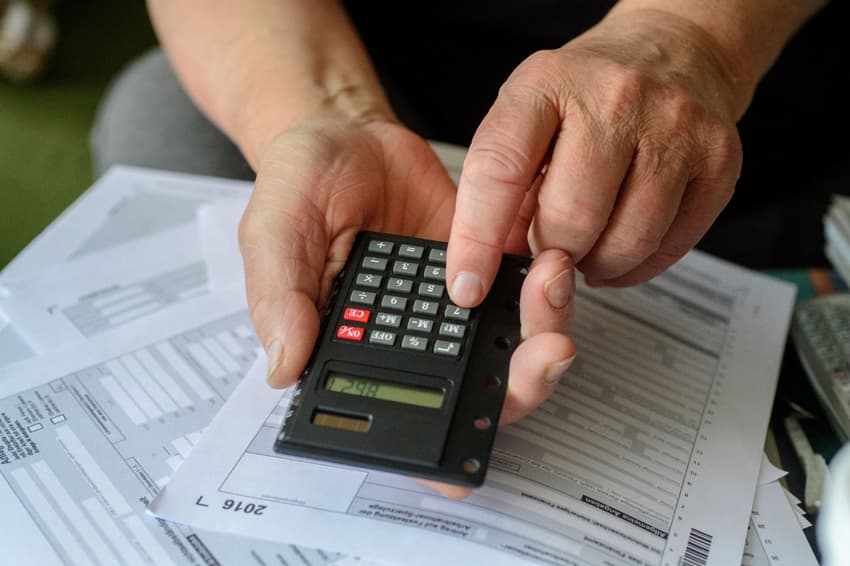Why taxes on pensioners in Germany have risen up to 500 percent since 2010

The tax burden on pensioners has increased fivefold within ten years in some cases, according to figures released by the Finance Ministry on Wednesday.
For example, new pensioners now have to pay €430 in income tax per year on a monthly gross pension of €1500, compared with €79 in 2010.
The figures were released on Wednesday, as part of an inquiry submitted to the Federal Ministry of Finance by Die Linke.
READ ALSO: How to maximize your German pension - even if you plan to retire elsewhere
For an individual with a monthly gross pension of €1700, €294 was due at the start of pension payments in 2010. This year that figure has risen to €758.
If the monthly earnings were €2000, €679 in taxes would have been due in 2010. Now the figure has risen to €1326.
Die Linke Left Party leader Dietmar Bartsch criticized the increasing pension taxation as a "de facto pension cut".
Why is there an increase?
The sharp increase is due to a change which was introduced in 2005. Until then, a tax-free allowance of 50 percent of the pension was permitted.
Since then, the tax rate on pensions has risen by two percentage points annually.
Health and long-term care insurance contributions and some everyday expenses can also be claimed.
The tax becomes due when the total income of a pensioner exceeds the basic annual tax-free allowance (€9168 or €764 per month). The average monthly pension in 2018 was €1219.
"In the next few years, the tax burden for small and medium-sized pensions will continue to rise,” Barsch told DPA.
He called on Finance Minister Olaf Scholz and Labour Minister Hubertus Heil (both SPD) to present a plan with significantly higher tax allowances to protect small and medium-sized pensions.
In 2015, a total of €34.65 billion in income tax was paid to the state by taxpayers with pension income.
There is currently a push around Germany to raise the pension age to 69, up from 67, in light of rising lifespans.
Read more of our coverage of pensions in Germany HERE.
Vocabulary
Tax burden - (die) Steuerbelastung, (die) Steuerlast
Fivefold - um das Fünffache
due/payable - fällig
Pension contributions - (die) Rentenbeiträge
Basic tax-free allowance - (der) Grundfreibetrag
To deduct - abziehen
We're aiming to help our readers improve their German by translating vocabulary from some of our news stories. Did you find this article useful? Let us know.
Comments
See Also
For example, new pensioners now have to pay €430 in income tax per year on a monthly gross pension of €1500, compared with €79 in 2010.
The figures were released on Wednesday, as part of an inquiry submitted to the Federal Ministry of Finance by Die Linke.
READ ALSO: How to maximize your German pension - even if you plan to retire elsewhere
For an individual with a monthly gross pension of €1700, €294 was due at the start of pension payments in 2010. This year that figure has risen to €758.
If the monthly earnings were €2000, €679 in taxes would have been due in 2010. Now the figure has risen to €1326.
Die Linke Left Party leader Dietmar Bartsch criticized the increasing pension taxation as a "de facto pension cut".
Why is there an increase?
The sharp increase is due to a change which was introduced in 2005. Until then, a tax-free allowance of 50 percent of the pension was permitted.
Since then, the tax rate on pensions has risen by two percentage points annually.
Health and long-term care insurance contributions and some everyday expenses can also be claimed.
The tax becomes due when the total income of a pensioner exceeds the basic annual tax-free allowance (€9168 or €764 per month). The average monthly pension in 2018 was €1219.
"In the next few years, the tax burden for small and medium-sized pensions will continue to rise,” Barsch told DPA.
He called on Finance Minister Olaf Scholz and Labour Minister Hubertus Heil (both SPD) to present a plan with significantly higher tax allowances to protect small and medium-sized pensions.
In 2015, a total of €34.65 billion in income tax was paid to the state by taxpayers with pension income.
There is currently a push around Germany to raise the pension age to 69, up from 67, in light of rising lifespans.
Read more of our coverage of pensions in Germany HERE.
Vocabulary
Tax burden - (die) Steuerbelastung, (die) Steuerlast
Fivefold - um das Fünffache
due/payable - fällig
Pension contributions - (die) Rentenbeiträge
Basic tax-free allowance - (der) Grundfreibetrag
To deduct - abziehen
We're aiming to help our readers improve their German by translating vocabulary from some of our news stories. Did you find this article useful? Let us know.
Join the conversation in our comments section below. Share your own views and experience and if you have a question or suggestion for our journalists then email us at [email protected].
Please keep comments civil, constructive and on topic – and make sure to read our terms of use before getting involved.
Please log in here to leave a comment.